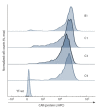shp-2 gene knockout upregulates CAR-driven cytotoxicity of YT NK cells
- PMID: 33659784
- PMCID: PMC7716529
- DOI: 10.18699/VJ20.598
shp-2 gene knockout upregulates CAR-driven cytotoxicity of YT NK cells
Abstract
In Russia, cancer is the second leading cause of death following cardiovascular diseases. Adoptive transfer of NK cells is a promising approach to fight cancer; however, for their successful use in cancer treatment, it is necessary to ensure their robust accumulation at tumor foci, provide resistance to the immunosuppressive tumor microenvironment, and to engineer them with higher cytotoxic activity. NK lymphocytes are known to kill cancer cells expressing a number of stress ligands; and the balance of signals from inhibitory and activating receptors on the surface of the NK cell determines whether a cytotoxic reaction is triggered. We hypothesized that stronger cytotoxicity of NK cells could be achieved via gene editing aimed at enhancing the activating signaling cascades and/or weakening the inhibitory ones, thereby shifting the balance of signals towards NK cell activation and target cell lysis. Here, we took advantage of the CRISPR/Cas9 system to introduce mutations in the coding sequence of the shp-2 (PTPN11) gene encoding the signaling molecule of inhibitory pathways in NK cells. These shp-2 knock-out NK cells were additionally transduced to express a chimeric antigen receptor (CAR) that selectively recognized the antigen of interest on the target cell surface and generated an activating signal. We demonstrate that the combination of shp-2 gene knockout and CAR expression increases the cytotoxicity of effector NK-like YT cells against human prostate cancer cell line Du-145 with ectopic expression of PSMA protein, which is specifically targeted by the CAR.
Одна из самых распространенных причин смертей пациентов в России, наряду с болезнями системы кровообращения, – это онкологические заболевания. Перспективным средством в борьбе с раковыми клетками представляются NK-клетки (естественные киллеры), однако для успешного применения в терапии онкологических заболеваний необходимо обеспечить их накопление в опухолевых очагах, устойчивость к иммуносупрессивному микроокружению, а также более высокую цитотоксическую активность. Известно, что NK-лимфоциты уничтожают раковые клетки, экспрессирующие специфические стресс-лиганды; при этом баланс сигналов от ингибирующих и активирующих рецепторов на поверхности NK-клетки определяет, будет ли запущена цитотоксическая реакция. Один из теоретически возможных способов повышения цитотоксичности состоит в том, чтобы при помощи генетического редактирования усилить активационные сигнальные каскады в NK-клетках и/ или ослабить ингибирующие, таким образом сместив баланс сигналов в сторону активации лимфоцитов и лизиса мишеней. NK-клетки с таким модифицированным цитотоксическим потенциалом могут эффективнее уничтожать раковые мишени, обладающие так называемой устойчивостью к лизису. В этой работе мы предлагаем дважды модифицировать NK-клетки. Во-первых, при помощи системы CRISPR/Cas9 проводить нокаутирование гена shp- 2 (PTPN11), кодирующего белок Shp-2 – негативный регулятор активации NK-клеток; во-вторых, при помощи лентивирусных векторов интегрировать кассету, кодирующую CAR (химерный антигенный рецептор), способный специфично связываться с антигенами на поверхности раковой мишени и генерировать активирующий сигнал. В качестве модельной NK-клеточной линии нами была выбрана перевиваемая линия NK-подобного фенотипа YT, поскольку эти клетки не нуждаются в специфических цитокинах для культивирования и могут проявлять перфорин/гранзим-опосредованную цитотоксическую активность. Мы показали, что сочетание нокаута гена shp-2 и экспрессии CAR повышает ци- тотоксичность эффекторных клеток на модели NK-устойчивой клеточной линии аденокарциномы простаты человека Du-145, экспрессирующей специфично узнаваемый CAR антиген, белок PSMA. Подобные линии с «усиленным» цитотоксическим фенотипом в перспективе могут быть использованы для нужд противорако- вой терапии.
Keywords: CAR-NK; CRISPR/Cas9; NK cells; Shp-2.
Copyright © AUTHORS, 2018.
Figures




LinkOut - more resources
Full Text Sources
Miscellaneous
